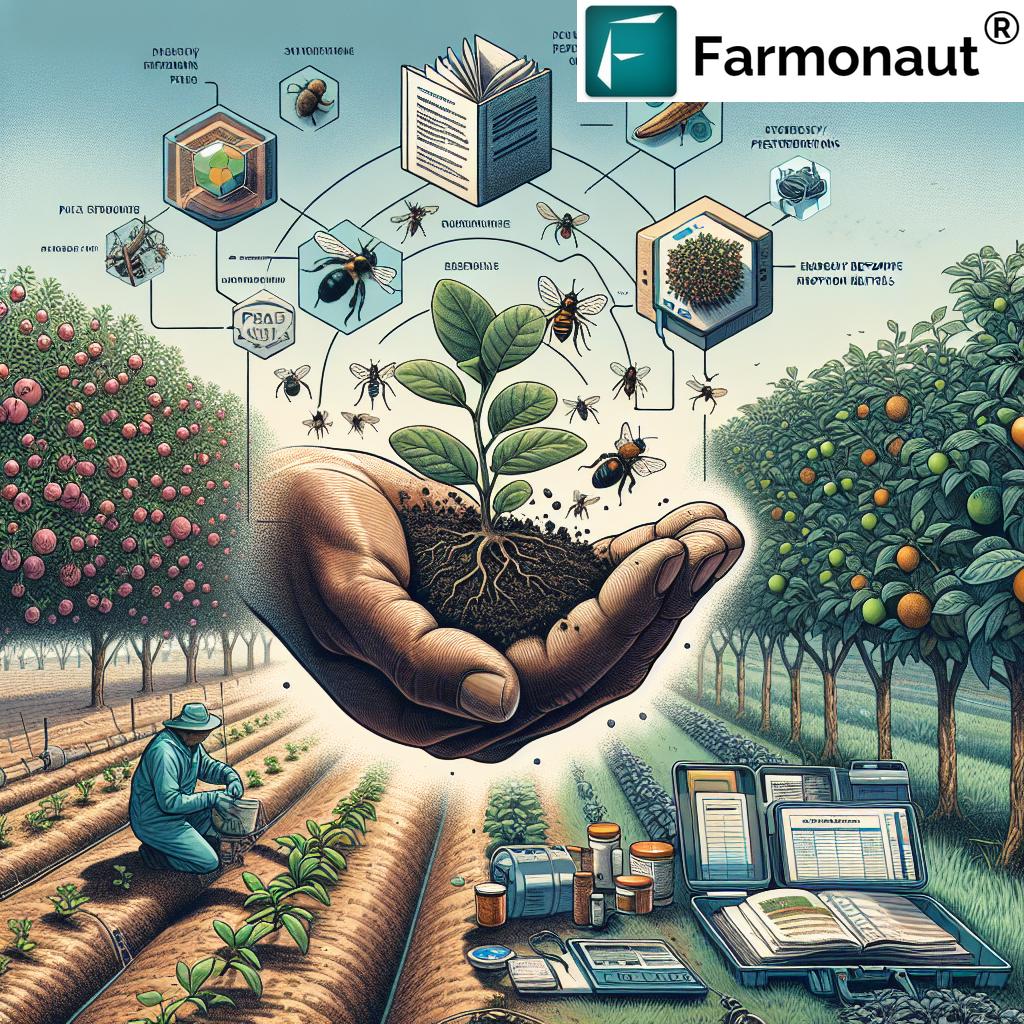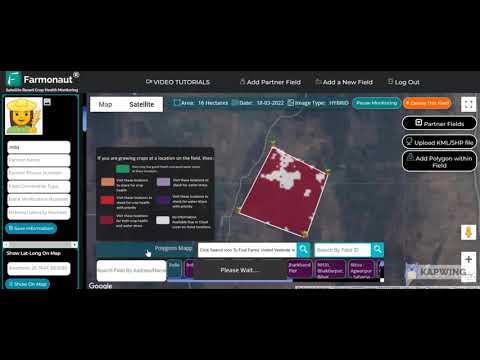Mastering Farm Biosecurity: Essential Practices for Sustainable Agriculture in Australia
In the ever-evolving landscape of Australian agriculture, farm biosecurity has emerged as a cornerstone of sustainable farming practices. At Farmonaut, we recognize the critical importance of implementing robust biosecurity measures to protect crops, livestock, and the environment. Our farm biosecurity program is designed to revolutionize crop pest management and livestock disease prevention, ensuring the longevity and productivity of farms across the country.

As we delve into the world of farm biosecurity, it’s crucial to understand its far-reaching implications. From safeguarding our food supply to maintaining biodiversity, the practices we’ll explore are fundamental to the future of agriculture in Australia and beyond.
“Australian farmers implementing biosecurity measures can protect up to 5 different crop types, including cotton, grains, and vegetables.”
Understanding Farm Biosecurity
Farm biosecurity encompasses a set of measures designed to protect a property from the entry and spread of pests, diseases, and weeds. It’s not just about preventing problems; it’s about creating a resilient agricultural system that can withstand various threats while maintaining productivity and sustainability.
- Pest Management: Implementing strategies to control and prevent pest infestations
- Disease Prevention: Establishing protocols to minimize the risk of disease outbreaks
- Weed Control: Developing methods to manage and eradicate invasive plant species
- Emergency Response: Creating plans to quickly address biosecurity breaches
By integrating these elements into a comprehensive farm biosecurity program, we can significantly reduce the risk of crop losses, livestock illnesses, and environmental damage.
The Importance of Biosecurity in Australian Agriculture
Australia’s unique ecosystem and geographical isolation make it particularly vulnerable to introduced pests and diseases. As such, maintaining strong biosecurity measures is not just beneficial—it’s essential for the survival and success of our agricultural industry.
- Protecting Biodiversity: Preserving native flora and fauna from invasive species
- Ensuring Food Safety: Minimizing the risk of contamination in the food supply chain
- Maintaining Market Access: Meeting international standards for agricultural exports
- Safeguarding Rural Communities: Protecting the livelihoods of farmers and agricultural workers
By prioritizing biosecurity, we’re not just protecting individual farms; we’re safeguarding the entire Australian agricultural sector and the communities that depend on it.
Farmonaut’s Approach to Farm Biosecurity
At Farmonaut, we leverage cutting-edge technology to enhance farm biosecurity practices. Our satellite-based crop health monitoring system provides real-time insights that are crucial for early detection of potential biosecurity threats.
Explore our advanced solutions:
Our platform integrates several key features that support robust biosecurity practices:
- Real-time Crop Health Monitoring: Detect potential pest or disease outbreaks early
- AI-driven Advisory System: Receive personalized recommendations for pest and disease management
- Resource Management Tools: Optimize the use of inputs to minimize biosecurity risks
- Blockchain-based Traceability: Ensure transparency and accountability in the supply chain
By harnessing these technologies, we empower farmers to take a proactive approach to biosecurity, addressing potential threats before they escalate into major issues.
Essential Biosecurity Practices for Crop Farming
Crop farming in Australia faces unique challenges, from managing pests in cotton fields to preventing diseases in grain crops. Implementing robust biosecurity measures is crucial for maintaining healthy and productive farms.
Cotton Biosecurity
Cotton is a major crop in Australia, and protecting it from pests and diseases is paramount. Key practices include:
- Implementing strict quarantine measures for new plant material
- Regular monitoring for signs of bollworm and other cotton pests
- Proper disposal of crop residues to prevent disease carryover
- Using resistant varieties and rotating crops to break pest cycles
Grain Biosecurity
Grain crops are susceptible to a variety of pests and diseases that can significantly impact yields. Essential practices include:
- Regular cleaning and disinfection of storage facilities
- Implementing pest-proof storage systems
- Monitoring for exotic pests like the Khapra beetle
- Maintaining hygiene protocols for machinery and vehicles
Vegetable Biosecurity
Vegetable crops require vigilant biosecurity measures due to their susceptibility to a wide range of pests and diseases. Key practices include:
- Implementing crop rotation to break disease cycles
- Using disease-free seedlings and planting material
- Regular scouting for signs of pests and diseases
- Maintaining strict hygiene protocols for workers and equipment
“Effective farm biosecurity practices can help prevent diseases in multiple livestock species and over 100 plant varieties simultaneously.”
Biosecurity Best Practices for Horticulture
The horticulture sector, encompassing fruit, nut, and nursery production, faces unique biosecurity challenges. Implementing comprehensive measures is essential for protecting these high-value crops.
Fruit and Nut Orchards
Biosecurity in orchards focuses on preventing the introduction and spread of pests and diseases that can devastate entire crops. Key practices include:
- Implementing strict visitor protocols to prevent the introduction of pests
- Regular pruning and orchard hygiene to minimize disease spread
- Monitoring for exotic pests like fruit flies and implementing trapping programs
- Using certified disease-free rootstock and planting material
Nursery and Garden Centers
As hubs for plant distribution, nurseries play a critical role in biosecurity. Essential practices include:
- Maintaining strict quarantine areas for new plant arrivals
- Implementing regular pest and disease monitoring programs
- Ensuring proper documentation and traceability of plant stock
- Training staff in pest and disease identification and reporting
Viticulture
The wine industry relies heavily on effective biosecurity measures to protect valuable grape crops. Key practices include:
- Implementing phylloxera exclusion zones to prevent the spread of this devastating pest
- Regular monitoring for signs of exotic diseases like Pierce’s disease
- Maintaining strict hygiene protocols for pruning and harvesting equipment
- Implementing traceability systems for grapevine material
Livestock Biosecurity: Protecting Animal Health
Livestock biosecurity is crucial for maintaining animal health, ensuring food safety, and protecting the Australian livestock industry. Implementing robust measures helps prevent the introduction and spread of diseases that can devastate herds and flocks.
Cattle and Dairy Farms
Biosecurity in cattle operations focuses on preventing diseases like foot-and-mouth disease and bovine Johne’s disease. Key practices include:
- Implementing quarantine protocols for new animals
- Maintaining clean and separate areas for calving
- Regular veterinary checks and disease testing
- Proper disposal of animal carcasses and waste
Sheep and Goat Farms
Small ruminants require specific biosecurity measures to prevent diseases like scrapie and ovine Johne’s disease. Essential practices include:
- Implementing footbaths to prevent the spread of foot rot
- Maintaining separate areas for lambing and kidding
- Regular shearing hygiene protocols
- Monitoring for signs of exotic diseases like sheep pox
Pig Farms
Pig farms are particularly vulnerable to diseases that can spread rapidly. Key biosecurity measures include:
- Implementing strict visitor protocols and shower-in, shower-out facilities
- Maintaining all-in, all-out production systems
- Regular cleaning and disinfection of housing areas
- Implementing pest control programs to prevent disease vectors
Poultry Farms
Biosecurity in poultry operations is crucial for preventing devastating outbreaks of diseases like avian influenza. Essential practices include:
- Implementing strict access controls and visitor logs
- Maintaining separate areas for different age groups of birds
- Regular cleaning and disinfection of housing and equipment
- Implementing rodent and wild bird control measures
Emergency Response and Disease Outbreak Management
Despite the best preventive measures, biosecurity emergencies can still occur. Having a well-prepared emergency response plan is crucial for minimizing the impact of disease outbreaks or pest incursions.
Developing an Emergency Response Plan
An effective emergency response plan should include:
- Clear communication protocols and contact lists
- Procedures for isolating affected areas or animals
- Guidelines for notifying relevant authorities
- Strategies for containing and eradicating the threat
Training and Preparedness
Regular training and simulations are essential for ensuring that all farm personnel are prepared to act swiftly in case of a biosecurity emergency. This includes:
- Conducting regular biosecurity drills and scenario planning
- Providing ongoing training on pest and disease identification
- Ensuring all staff are familiar with emergency response procedures
- Maintaining up-to-date emergency kits and supplies

Implementing On-Farm Biosecurity Measures
Effective biosecurity starts with implementing practical, day-to-day measures on the farm. These measures form the foundation of a robust biosecurity program and help prevent the introduction and spread of pests and diseases.
Farm Access and Vehicle Management
Controlling access to your farm is a critical component of biosecurity. Key practices include:
- Installing clear signage indicating biosecurity requirements
- Establishing designated parking areas away from production zones
- Implementing vehicle wash-down facilities for entering and exiting vehicles
- Maintaining a visitor log and providing biosecurity inductions for all visitors
Equipment and Tool Hygiene
Farm equipment and tools can inadvertently spread pests and diseases. Essential practices include:
- Regular cleaning and disinfection of all farm equipment
- Establishing clean-down areas for machinery between paddocks
- Using dedicated tools for quarantine or high-risk areas
- Implementing a “come clean, go clean” policy for all equipment
Managing Farm Inputs and Outputs
Careful management of what comes onto and leaves your farm is crucial for biosecurity. Key practices include:
- Inspecting all incoming feed, seed, and other inputs for signs of pests or contamination
- Implementing quarantine periods for new livestock
- Properly disposing of waste and dead animals to prevent disease spread
- Maintaining accurate records of all farm inputs and outputs
Biosecurity Best Practices for Specific Crops
Different crops have unique biosecurity requirements. Understanding and implementing these specific practices is crucial for maintaining healthy and productive crops.
Sugarcane Biosecurity
Sugarcane is vulnerable to several pests and diseases. Key biosecurity practices include:
- Implementing strict machinery hygiene protocols between farms
- Using approved seed cane sources to prevent disease introduction
- Regular monitoring for exotic pests like sugarcane smut
- Maintaining farm hygiene to minimize habitat for pests
Potato and Onion Biosecurity
Root crops require specific biosecurity measures. Essential practices include:
- Using certified disease-free seed potatoes and onion sets
- Implementing crop rotation to break disease cycles
- Regular soil testing for potato cyst nematode
- Proper cleaning of harvesting and grading equipment
Forestry and Plantation Biosecurity
Protecting Australia’s forests and timber plantations is crucial. Key practices include:
- Implementing hygiene protocols for vehicles and equipment entering forest areas
- Regular monitoring for signs of exotic pests like the Asian gypsy moth
- Maintaining firebreaks to prevent the spread of pests and diseases
- Using pest-resistant tree varieties in new plantations
Biosecurity in Beekeeping
Bees play a crucial role in agriculture, and protecting them from pests and diseases is essential. Key biosecurity practices for beekeepers include:
- Regular hive inspections for signs of pests like Varroa mite
- Maintaining clean beekeeping equipment and protective gear
- Implementing quarantine procedures for new hives or queens
- Participating in national bee pest surveillance programs
For the latest updates on bee biosecurity, subscribe to the Bee Aware newsletter.
Managing Feral Animals and Pests
Feral animals and pests pose significant biosecurity risks to Australian farms. Effective management strategies include:
- Implementing integrated pest management programs
- Regular monitoring and reporting of feral animal activity
- Maintaining farm fences to prevent incursions
- Collaborating with neighbors and local authorities on control programs
Particular attention should be paid to controlling wild dogs, which can spread diseases to livestock.
Biosecurity Training and Education
Continuous training and education are essential for maintaining effective biosecurity practices. Key elements include:
- Regular staff training on biosecurity protocols
- Participating in industry workshops and seminars
- Staying informed about new and emerging biosecurity threats
- Developing a culture of biosecurity awareness on the farm
Farmonaut offers comprehensive resources to support your biosecurity training efforts. Explore our API for access to real-time data that can enhance your biosecurity planning.
Record Keeping and Documentation
Maintaining accurate records is crucial for effective biosecurity management. Essential record-keeping practices include:
- Documenting all farm inputs and outputs
- Keeping detailed visitor logs
- Maintaining records of pest and disease monitoring activities
- Documenting all biosecurity-related training and procedures
Farmonaut’s platform offers robust tools for maintaining digital records, ensuring you have accurate and accessible data at your fingertips.
Biosecurity in Emerging Agricultural Industries
As new agricultural industries emerge in Australia, it’s crucial to develop tailored biosecurity practices. This includes:
- Conducting risk assessments for new crop or livestock species
- Developing industry-specific biosecurity plans
- Collaborating with research institutions to identify potential threats
- Implementing early warning systems for exotic pests and diseases
The Future of Farm Biosecurity
As we look to the future, farm biosecurity will continue to evolve. Emerging trends include:
- Increased use of remote sensing and AI for early threat detection
- Development of more resilient and disease-resistant crop varieties
- Enhanced traceability systems using blockchain technology
- Greater integration of biosecurity practices with sustainability initiatives
Farmonaut is at the forefront of these developments, continually innovating to provide farmers with cutting-edge tools for biosecurity management.
Biosecurity Practices Comparison Matrix
| Biosecurity Practice | Crop Farming | Horticulture | Livestock Farming | Estimated Implementation Cost | Potential Risk Reduction (%) |
|---|---|---|---|---|---|
| Pest Management | Integrated Pest Management (IPM), crop rotation | Regular monitoring, trapping programs | Vector control, pasture management | Medium | 70-80% |
| Disease Prevention | Use of resistant varieties, proper spacing | Pruning, orchard hygiene | Vaccination programs, quarantine protocols | High | 80-90% |
| Emergency Response | Rapid reporting, containment measures | Isolation of affected areas, eradication plans | Movement restrictions, culling if necessary | Very High | 90-95% |
| Farm Access Control | Signage, designated parking areas | Visitor logs, footbaths | Vehicle wash-down, restricted access zones | Low | 60-70% |
| Equipment Hygiene | Regular cleaning, dedicated tools | Sterilization of pruning equipment | Disinfection between paddocks | Medium | 75-85% |
Conclusion
Mastering farm biosecurity is essential for sustainable agriculture in Australia. By implementing the practices outlined in this guide, farmers can significantly reduce the risk of pest and disease outbreaks, protect their livelihoods, and contribute to the long-term health of Australia’s agricultural sector.
Farmonaut is committed to supporting farmers in their biosecurity efforts. Our advanced technology solutions provide real-time insights and tools to enhance your farm’s biosecurity measures. Explore our API Developer Docs to learn how you can integrate our powerful tools into your farm management systems.
Remember, effective biosecurity is an ongoing process that requires vigilance, dedication, and continuous improvement. By staying informed, implementing best practices, and leveraging cutting-edge technology, we can work together to create a more resilient and sustainable agricultural future for Australia.
FAQ Section
Q: What is farm biosecurity?
A: Farm biosecurity refers to a set of measures designed to protect a property from the entry and spread of pests, diseases, and weeds. It includes practices for managing risks to crops, livestock, and the environment.
Q: Why is biosecurity important for Australian agriculture?
A: Biosecurity is crucial for protecting Australia’s unique ecosystem, ensuring food safety, maintaining market access for exports, and safeguarding the livelihoods of farmers and rural communities.
Q: How can technology help with farm biosecurity?
A: Technologies like satellite monitoring, AI-driven advisory systems, and blockchain-based traceability can enhance early detection of threats, provide targeted recommendations, and improve supply chain transparency.
Q: What are some key biosecurity practices for crop farming?
A: Essential practices include implementing quarantine measures, regular monitoring for pests and diseases, proper disposal of crop residues, and using resistant crop varieties.
Q: How can livestock farmers improve their biosecurity?
A: Livestock farmers can enhance biosecurity by implementing quarantine protocols for new animals, maintaining clean calving/lambing areas, conducting regular veterinary checks, and properly disposing of animal carcasses and waste.
Q: What should be included in a farm biosecurity emergency response plan?
A: An effective plan should include clear communication protocols, procedures for isolating affected areas or animals, guidelines for notifying authorities, and strategies for containing and eradicating threats.
Q: How often should biosecurity training be conducted?
A: Biosecurity training should be conducted regularly, ideally at least annually, with additional sessions when new threats emerge or significant changes occur in farm operations.
Q: What role does record-keeping play in farm biosecurity?
A: Accurate record-keeping is crucial for tracking farm inputs and outputs, monitoring visitor access, documenting pest and disease occurrences, and maintaining a history of biosecurity practices and training.






